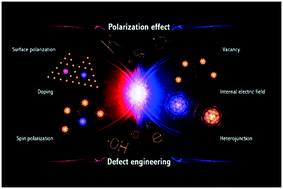High carrier separation efficiency for a defective g-C3N4 with polarization effect and defect engineering: mechanism, properties and prospects
Abstract
As a green, visible-light-driven metal-free semiconductor material, graphitic carbon nitride (g-C3N4) has generated tremendous significance in the fields of environmental purification and energy conversion. Inducing a polarization effect by creating defects in g-C3N4 is a promising strategy for improving photocatalytic properties. The polarization effect in photocatalysts could be created by manufacturing vacancies, doping impurity atoms, constructing heterostructure, etc. Recently, defective g-C3N4 has attracted wide attention due to its remarkable performance in the separation and migration of photogenerated charge carriers. However, the relationship between defects and the polarization effect remains to be clarified in terms of improving the photocatalytic performance. In this minireview, we summarize the recent advances on how the polarization effect and defect engineering expedite the photogenerated carrier migration and separation to improve the photocatalytic properties of g-C3N4. Is it pure synergy or is there some degree of antagonism? Ultimately, the major challenges for simply constructing the polarization effect and internal electric field in g-C3N4 and inspiring perspectives for future opportunities in polarization-defect type photocatalysis are discussed. It is believed that this work can provide a new idea for the design of novel and efficient photocatalysts in the future.



 Please wait while we load your content...
Please wait while we load your content...